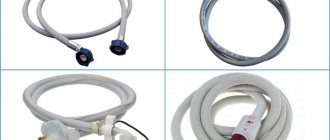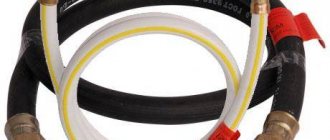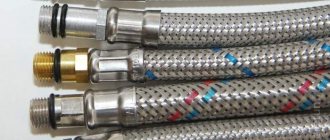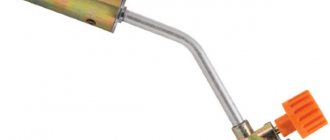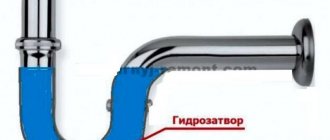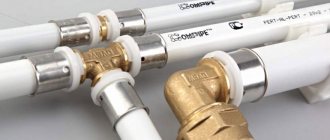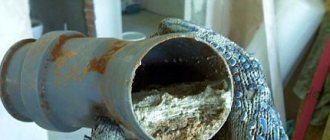Previously, in gasified houses, the gas stove was connected directly to the gas pipeline using a steel pipe. The method was considered safe, but caused some inconvenience. The main disadvantage of a rigid installation was the impossibility of moving the stove to a convenient position in order to properly organize the work area. A modern flexible gas hose for a gas stove is considered no less safe, but allows you to install the hob where it is convenient.
Only a correctly selected gas hose guarantees safe connection and reliable operation.
Gas hose for gas stove: the right choice that guarantees safety
Previously, in gasified houses, the gas stove was connected directly to the gas pipeline using a steel pipe. The method was considered safe, but caused some inconvenience. The main disadvantage of a rigid installation was the impossibility of moving the stove to a convenient position in order to properly organize the work area. A modern flexible hose for a gas stove is considered no less safe, but allows you to install the hob where it is convenient.
Only a correctly selected gas hose guarantees safe connection and reliable operation.
What do you need to consider for connection security?
Gas is not something to joke about, so it is better to entrust the work to a professional who is familiar with all the nuances. But if you familiarize yourself with the basic rules, you will be able to control its work from the outside, and when the opportunity arises, you will be able to show off the knowledge you have acquired. So:
- In order not to encounter problems in the future, you need to estimate in advance how far you are going to pull out the stove in case of, for example, cleaning. The length of the required hose depends on this.
- The product must be visible so that it can be constantly checked.
- Excessive tension, bending and twisting are unacceptable.
- Exposure to high temperatures is excluded.
- The elements are connected to each other only this way: copper to brass, steel to steel.
- They are tightened tightly, but not too enthusiastically, otherwise the thread may be damaged.
Read also: Wood trimming machine
Now you have learned about gas hoses for gas stoves: which one is best for you? If you value reliability and durability, then there is only one way out - buy a bellows product that will provide you with safety, and therefore comfort for a long time.
Please check out this review:
In the last century, the connection of gas stoves was carried out only by laying steel pipes, which was fully consistent with the current rules for the installation and operation of gas equipment. The slab was installed rigidly - it was no longer possible to move it. With the advent of imported household appliances and accompanying accessories, flexible products began to appear in specialized stores selling gas stoves, which were a curiosity for our consumers. But over time, a hose for connecting a gas stove appeared in almost every home and became an alternative to steel pipes due to its obvious advantages and convenient use.
What is a hose for a gas pipe: the main requirements for the product
In appearance, the hose for connecting a gas stove is very similar to a water supply. The main difference between a gas device is the presence of yellow or white markings, which should be visible. In addition, the flexible hose for the gas stove is made of a special material. Another feature is the presence of a paronite gasket - a special ring that is used to seal the flange connection. It is the presence of the gasket that ensures the safety of using the products.
In appearance, the hose for connecting a gas stove is very similar to a water supply.
Note! If you are wondering what kind of hose is needed for a gas stove, then the main component here is the presence of the appropriate markings and a certificate issued by Rostechnadzor of Russia.
This document confirms that the product meets safety requirements. In addition, the hose must be accompanied by a passport indicating the date of its manufacture. Purchasing a high-quality and certified product will ensure the safe use of gas, but purchasing a hose of dubious quality without the appropriate documents can lead to tragedy.
Other mandatory requirements for a flexible gas hose for a stove:
- The product must be complete, without additional couplings, extensions or connections.
- It is necessary that the flexible liner have a special coating that is resistant to hot liquids and high temperatures.
- The hose must not be subject to corrosion.
- The parameters of the product must correspond to the characteristics of the gas used.
- The service life of a gas hose for a gas stove should not be less than 10 years.
It is unacceptable to connect several hoses together - it is better to immediately purchase a hose for a gas stove, the length of which will correspond to the distance between the gas pipe and the hob. The maximum length of a gas hose for connecting a stove according to European standards is 2 meters, although a seven-meter hose is considered the longest certified product. If you look at the relevant Russian GOSTs, you will notice that they do not contain recommendations regarding the length of the gas hose. In any case, you should not install the stove too far from the gas pipe.
The main types of hoses include: oxygen, reinforced rubber, rubber-fabric, reinforced PVC hoses, bellows.
Now the market offers a large number of different options for mobile gas connections. The materials used in production also differ in technical characteristics that affect their service life. Therefore, in order to understand what the hose for a gas stove should be like in a particular situation, you need to take into account the location and features of use of the hob.
The main types of hoses include:
- oxygen;
- reinforced rubber;
- rubber-fabric;
- reinforced PVC hoses;
- bellows.
Conclusion
As you can see, today there are three main types of flexible hoses for gas equipment. At the moment, the most common are ordinary products with metal braid. This is due to the fact that this particular type has the optimal price-quality ratio.
Of course, rubber materials are cheaper, but also less durable. As for the third type, their high price is due to their high performance indicators, as well as the fact that a large number of products are produced abroad.
Gas hose for gas stove: main types of products
Oxygen hoses were mainly used during Soviet times due to the lack of alternative options. To produce this type of hose, a special cord thread is used, and an additional material that is applied to protect the thread is a rubber compound.
In modern times, an oxygen hose is more often used for welding or for transporting gas mixtures such as acetylene, butane and propane. Sometimes a hose is used to connect a gas cylinder as a fuel source, which is installed far from the stove for safety. The permissible temperature range at which the product can be used is from +70 to -35 degrees Celsius.
In the past, oxygen hoses were used due to a lack of alternative options.
Positive aspects of using oxygen hoses:
- withstand pressure up to 20 atm;
- easy to install;
- do not conduct electricity;
- are characterized by low cost;
- Suitable for different pipe diameters.
In modern apartments, it is not recommended to use oxygen hoses to connect stoves, because, firstly, the products do not have a very attractive black color, and secondly, they cannot be repainted. When oil solutions enter, the surface of the hose heats up and loss of integrity is possible, which will lead to gas leakage. The cost varies from 70 to 90 rubles. per meter
A fabric-based rubber sleeve is a simple and inexpensive option. The hose has a rubber base reinforced with durable textile thread. Thanks to the additional components that are added to the rubber mixture, the service life of a gas hose for a stove is about 5 years, which is still not enough for a quality product.
Another disadvantage of the application is the fact that after a while cracks may appear on the surface, which can cause a gas leak. The product has a small operating temperature range, which is only from -10 to +50 °C. Positive properties include ease of use, ease of installation, ability to bend well and excellent electrical insulation.
A fabric-based rubber sleeve is a simple and inexpensive option.
Note! Rubber hoses for gas stoves with fabric braiding must have a yellow label, which distinguishes them from products for water.
Most often recommended for connecting the hob to a gas cylinder. Experts advise replacing the hose every 2-3 years.
Reinforced hoses: polymer, rubber, steel
Polymer materials are located inside such a hose. The next layer is vulcanized rubber. On the outside, it is braided with steel threads. In order not to confuse the products with similar water hoses, a yellow thread is woven into them.
Reinforced hoses are quite popular, the reasons for which are:
- simple installation and ease of operation;
- reliability and decent shelf life;
- variety of assortment - both in diameter and length;
- safe use at temperatures from -35° to +50°.
Let us also note a significant disadvantage - the unimportant level of electrical insulation, the culprit of which is the metal braid. Therefore, when installing, you usually have to insert a dielectric coupling between the plate and the supply line. There is another drawback - the unreliability of the internal polymer material. For this reason, they have become “persona non grata” in some European countries, and recently the same trend has been emerging in our country.
Other types of gas hoses for gas stoves: sizes, prices
A gas rubber hose in a metal braid has an internal part made of polymer materials, which is covered with a layer of vulcanized rubber on top. On the outside, the hoses are braided with special steel threads, creating a so-called reinforced layer.
The main disadvantage of using hoses is considered to be the high ability of steel to transmit electricity, as well as the susceptibility of the internal polymer material to destruction, which may not be noticed due to the presence of upper layers. If the stove is not in use, it is recommended to shut off the gas hose during this time, which will increase its service life. The price for a finished product 60 cm long starts from 140 rubles.
When using this type of connection, you additionally need to install dielectric inserts, which are installed at the junction of the hose and the gas pipe. The presence of a dielectric will protect the gas stove and the hose itself from the effects of stray current, which can cause a fire.
A gas rubber hose in a metal braid has a disadvantage - it is the high ability of steel to transmit electricity.
Advantages of using rubber reinforced hose:
- affordable price;
- ease of installation;
- operation in a wide temperature range: from -35 to +50 °C;
- wide choice of length and diameter.
Reinforced PVC hose is considered more modern than the options listed above due to the fact that the characteristics of the material do not allow the product to conduct electric current. In addition, polyvinyl chloride does not break down as easily as rubber. Additional strength to the hose is provided by the presence of two layers of PVC. Inside the sleeve there is a black material, and the top layer is most often distinguished by a yellow color. It is used for supplying various types of gas mixtures: acetylene, propane and butane.
The PVC gas hose for a gas stove is designed for operating pressure up to 0.63 MPa, and the temperature at which gas can be operated varies from -20 to +90 °C, which is a significant advantage. Another positive aspect of using PVC products is the wide range of sizes, with the maximum length of a gas hose for a gas stove being 5 meters and the minimum length being 0.4 m. Galvanized steel is used for the manufacture of fittings, and dielectric properties are ensured due to the presence of a paronite gasket.
Other advantages of the product:
- does not collapse upon contact with a hot stove;
- affordable cost, price per meter of product starts from 170 rubles;
- not subject to destruction when exposed to hot drops of oil;
- suitable for use under high load conditions;
- long service life: minimum – 12 years, maximum – 20 years.
The PVC gas hose is considered more modern and is used for supplying various types of gas mixtures.
Varieties
There are only three types of gas hoses used in everyday life:
- Rubber-fabric.
- Rubber reinforced.
- Bellows.
They are made from various materials, have different technical properties and service life. Each of the three types of gas hoses has both pros and cons. The choice depends on the installation location and the specific case.
Rubber
Rubber hoses reinforced with textile thread are the softest among all types of hoses. They are economical, easy to install and maintain. A wide selection of hoses of this type is available in construction stores. You can easily select a sleeve of the desired length and diameter.
Photo 1. Rubber soft gas hose, black, is economical and easy to connect.
In addition, these hoses lack rigidity and are sensitive to temperature changes. This type of hose is recommended to be replaced every two years, however, in practice they are used much longer. Modern sleeves with elastic components can last up to 5 years.
Reinforced
Much more common are reinforced rubber hoses, which are similar to water supply hoses. They are braided with steel threads on the outside. The inside is made of polymer material, although they are called rubber.
Photo 2. Two reinforced hoses made of polymer material, one covered with corrugated steel on top.
The polymer sleeve inside is destroyed in the same way as the rubber one. In addition, steel is an excellent conductor of current, so it is necessary to use dielectric spacers during installation. When using metal-braided tubes, be sure to turn off the gas taps; this will extend the service life of the hoses. This type of hose can be used at temperatures up to +50 degrees.
Bellows Gas Hose: Best for Gas Stove
If you ask a specialist what type of hose for a gas stove should be, most likely he will suggest purchasing a bellows version for installation. This type of hose is considered the most reliable for connecting the hob to the central gas supply. In addition to gas stoves, it is used to connect water heaters and gas boilers used for individual heating. A bellows is an elastic corrugated shell that protects the inner layer from mechanical and other types of damage.
Corrugated stainless steel pipe: (read more)
The great demand for bellows hoses is due to the high technical characteristics and reliability of the devices. The products easily withstand the high pressure created by the gas flow in the pipe. Ease of connection is provided by two fittings designed for connection to a gas pipe and directly to the device. All hose components are made from high-quality stainless steel, which guarantees maximum service life.
Helpful advice! For a safer connection when connecting the hose, a special gasket made of plastic or soft metal is additionally used.
The bellows gas hose is considered the most reliable for connecting the hob to the central gas supply.
The price of a gas hose for a gas stove of this type is significantly higher than the cost of other product options, but the service life is at least 10 years longer than the service life of other devices. So, the minimum time during which you can safely use a bellows hose is 25 years, although some companies give a 30-year warranty. The final price is usually influenced by the manufacturer and size of the product.
You can find out how much a gas hose for a gas stove costs (depending on the characteristics) from this table:
| Connector diameter, inch | Length, m | Price, rubles |
| 1/2 | 0,4 | from 250 |
| 0,8 | from 290 | |
| 1 | from 320 | |
| 1,5 | from 400 | |
| 3 | from 780 | |
| 4 | from 950 | |
| 5 | from 1150 | |
| 3/4 | 0,6 | from 350 |
| 1 | from 450 | |
| 2 | from 700 | |
| 2,5 | from 900 | |
| 3 | from 1050 |
Bellows connection for gas: what is it, main characteristics
The bellows flexible liner is a metal corrugated hose, for the manufacture of which high-quality stainless steel is used. Thanks to this feature, the hose can be stretched and its length increased. At the ends of the device there are usually 2 nuts, which are used to connect gas equipment to the fuel supply pipe, or a nut and a fitting. Stainless steel is also used in the production of fittings, which is not subject to corrosion and rust.
To connect a flexible bellows-type gas connection to the equipment and directly to the gas pipe, union nuts are used. It is mandatory to install a metal gasket made of copper or aluminum between the inlet pipe and the product - sometimes special plastic is used for this purpose.
At the ends of the hose there are two fittings, which are made of stainless steel
If you choose a bellows-type gas hose made not by European, but, for example, Chinese or Turkish manufacturers, then you should take into account that instead of stainless steel they use carbon steel, which is more brittle and more susceptible to destruction. Therefore, when purchasing a gas liner, it is recommended to give preference to products with the following markings:
- stainless steel hose: AISI 316;
- steel fitting: AISI 304 or 303.
Experts advise that when choosing a hose, be sure to check that both the fitting and the corrugation are made of the same material. This is due to the fact that each material has a certain density and strength. If different types of metal are welded together, an electrochemical reaction may occur that can destroy the welded joint, which will lead to a loss of strength of the device.
You should not purchase products where the fitting is attached to the corrugation using an adhesive mixture. You should also not buy hoses in which the fitting is soldered using tin or silver. In this case, the products will not last long, and their strength may also be called into question.
Therefore, when purchasing, you should pay attention to the fact that the price of the gas hose should not be suspiciously low
Bellows liner can withstand pressure up to 6 atmospheres
Main technical characteristics of bellows hoses for gas
Like any other product, a bellows gas hose has specific features and parameters that set it apart from other options. Among the main characteristics it is worth noting the following:
- The products can be used over a wide range of temperature changes - from -50 to + 250 °C, and at any temperature within these limits the hose does not lose its qualities.
- The maximum pressure for which the hose is designed is 6 atmospheres. It must be taken into account that according to the standards, the maximum pressure at which gas can enter residential premises is 0.03 atm. From this we can conclude that the safety margin of the product is 200%.
- Thanks to the corrugated surface, the product can be extended to 2 times its original size. This ability is ensured by the use of high-quality stainless material that has been pre-annealed.
- Long period of operation. The service life of a bellows gas hose is 20-25 years, although some manufacturers offer a 30-year warranty.
Useful advice! Despite the fact that the product can be stretched, it is not recommended to double it: the more the hose is stretched, the more its rigidity decreases. Therefore, the maximum stretch that can be applied to the product is 50%.
Bellows hoses are equipped with a corrugated casing that protects the inner hose from damage
A very important point when choosing a bellows-type metal gas hose is the availability of a quality certificate confirming that the product is intended for use with explosive substances. The passport must indicate the fact that the product has been tested and meets all safety requirements
It is necessary to pay attention to the production time and service life of the hose
The main advantages and disadvantages of using bellows hoses
Simple models of bellows hose are presented in the form of corrugated products, which are distinguished by the presence of a round cross-section. If you choose a more expensive option, then in addition there will be a metal sleeve or polymer coating for protection. The modernized version of the bellows hose has a built-in thermal protection valve, which, when the temperature rises critically, independently shuts off the flow of gas. Of course, this option will also affect how much the hose costs, but the losses that can be incurred in the event of a gas leak will be much higher.
Other advantages of bellows hoses:
- easily bend and stretch;
- can withstand loads up to 6 atm;
- are operated in a wide temperature range from -50 to +200 °C;
- are made of high-quality materials that comply with all GOST standards;
- meet the technical requirements for domestic use;
- maximum possible service life - up to 30 years from the date of installation;
- withstand the influence of electric current up to 1.5 kW;
- a large selection of hose lengths for connecting a gas stove - from 0.4 to 5 m;
- compatibility with most types of gas equipment and various accessories;
- the presence of a coating that protects the base of the hose from the effects of various household chemicals used for cleaning and disinfecting the kitchen.
Simple models of bellows hose are presented in the form of corrugated products.
Additional safety for the hose is provided by an electrically insulating polymer layer, which protects not only from mechanical stress, but also from high-frequency currents that are created by some household appliances, for example, a microwave oven. Due to the strength of the hose, manufacturers guarantee the integrity of the connection even in the event of natural anomalies, such as an earthquake, when the stability of the building is compromised.
The only relative disadvantages include the price, which is several times higher than the cost of similar products from other groups. However, the presence of a large number of positive characteristics, which include a significant service life, covers this drawback.
On a note! When installing a stove or hob with a built-in electric ignition function, experts recommend additionally installing a dielectric insert between the gas supply tap and the bellows hose to ensure greater safety.
How to choose a hose
When purchasing any hose that is used to connect the stove to the gas pipeline, you must follow the recommendations of specialists.
- It is necessary to purchase products in special stores that sell certified products.
- Under no circumstances should you buy Chinese products - even with a certificate of suitability, they do not meet safety requirements, because the hoses are made of thinner rubber, which wears out very quickly. Counterfeits are very difficult to distinguish visually.
- Any type of gas hose should have a yellow mark on it, indicating that it is intended for a gas connection, and not for water, where the marks are red and blue.
- Products have lengths from 1.5 to 4.5 m, various diameters and threaded ends of half and three quarter inches. Only nuts or a nut and a fitting can be installed at both ends - it depends on where this type will be used.
When purchasing, check the hose visually for mechanical damage, scratches, cracks, even if the seller is against it.
Gas hoses for stoves: which one is better, the main rules for choosing
The main rule when choosing a gas hose is to purchase the product from a certified store. If the seller cannot provide a certificate of quality and does not give any guarantees, you should not buy the product from such a place. Typically, retail outlets provide a large selection of sizes of gas hoses for gas stoves. It is important to first take all measurements and buy a product of the required length, because it is not recommended to splice two products together.
It is important to first take all measurements and buy a product of the required length.
To reduce the risk of line rupture, it is not recommended to choose a length where, after installation, the hose will be under constant tension, since this may negatively affect the service life of the product. The maximum length of a gas hose for a stove in an apartment should not exceed 2-2.5 meters, although there are various size options, including 4 and 5 meters. Additionally, you need to ensure that the product not only does not stretch during installation, but also does not sag too much. Only a hose that is correctly selected in length guarantees safe connection and proper operation.
Another important indicator is the cross-sectional diameter of the hose. Here you need to know that the minimum size to ensure normal gas flow to the device is 1 cm. In this case, there must be two nuts or one fitting and one nut at the ends of the product. It must be taken into account that the nut is distinguished by the presence of an internal thread, while the fitting has an external thread. The cross-sectional diameter must be selected depending on the size of the outlet on the gas appliance. For ease of installation, there is an angle fitting that simplifies the connection process.
The most budget-friendly type of hose is considered to be a rubber-fabric product. It should be noted that, having chosen this option, you need to constantly monitor its integrity - if necessary, you can use a soap solution, which makes it easy to detect a leak. If even the slightest violation of integrity occurs, the product must be replaced. The best combination of price and quality include reinforced PVC hoses, which also have a long service life.
In any case, the bellows hose is considered the most reliable and safe, which has received official approval from state gas services for use in domestic conditions. When choosing this type of product, it is imperative to pay attention to the type and quality of the connection.
The main rule when choosing gas hoses is to purchase products from certified stores.
On a note! You should not choose a hose that uses glue to connect the fitting to the corrugation. The best option is considered to be a solid product or a structure held together by welding.
When purchasing, it is very important to be able to distinguish an original product from a Chinese counterfeit, which is why it is recommended to choose the product in specialized stores. In order not to purchase a fake, the hose should be carefully inspected for defects, and also study the passport attached to the product. You should also familiarize yourself with the price range so as not to buy a hose with a suspiciously low cost. The most important thing is to inspect the product for integrity.
Pitfalls of eyeliner
Just a decade and a half to two decades ago, the question of how to connect a gas stove to a distribution riser did not exist at all: domestic standards allowed only a rigid gas supply using a system of pipes, bends and angles. All this equipment was skillfully installed by gas service masters, and the stove was forever chained to its designated place. It was simply impossible to move it away, for example, during cleaning.
Flooded into our country in the early 90s. The flow of imported household appliances, including gas stoves, brought such a convenient means of connecting them as flexible hoses. The ease with which it was possible to connect the new stove to the riser was captivating. The downside of this simplicity was that anyone who considered himself a master began to take on the responsible work of connecting. The consequences in the form of domestic gas leaks were not long in coming...
Currently, flexible eyeliner has received the right to exist, secured by regulatory documents. But in this delicate area there are pitfalls that you need to be aware of.
How much does it cost to connect a gas stove: is it possible to install it yourself
When installing the stove, you need to choose the right hose taking into account the features of the gas tap. Depending on this, the connection can be either a nut-fitting or a nut-nut. Some gas stoves are distinguished by the presence of several inlet pipes, although only one is used - in this situation, the excess outlet is closed with a plug. The price for connecting a gas stove in Moscow from certified technicians starts from 1,300 rubles for a stove and from 1,500 rubles for a built-in hob.
The price for connecting a gas stove from certified technicians starts from 1,300 rubles.
If you have not previously had experience connecting a stove to a gas pipe, it is better to entrust this matter to professionals. In any case, it is important to adhere to basic safety rules:
- The hose should be located in a visible place so that damage can be observed. It must not be covered with furniture or household appliances.
- It is only permissible to place a wire near the product that provides illumination or electric ignition of a gas appliance.
- Do not paint the surface of the gas hose.
- Parts made of metal must be protected from condensation and moisture, which can lead to oxidation of the product.
- Do not connect hoses made of different materials to each other.
- After installation, a little sagging is acceptable, but there should be no tension.
- The device must not be kinked or twisted.
- The connections must be tightened tightly, but without excessive force, so as not to strip the threads.
- It is better not to use the hose for an extended period - it must be replaced after the time specified in the passport.
When installing the stove, you need to choose the right hose taking into account the features of the gas tap.
On a note! It is recommended to periodically apply a soap solution to the hose and joints to prevent damage and possible gas leaks.
Choosing a gas hose to connect a stove or water heater is a serious task, the competent execution of which determines the safety of not only the family, but also the entire residential building. The service life of the product depends on how high-quality the hose is chosen and on the correctness of its installation. It is very important to pay attention to the markings so as not to accidentally use a water hose to connect the gas. If you lack experience, it is better to entrust the selection and installation to professionals.
Connection to a domestic stove
On the back side of the plate we find the entrance - the fitting. The receiver can be straight or corner. With a direct entrance, when the gas riser is located to the side, there is a need to purchase a metal corner with an internal thread and a limiter into which paronite gaskets are placed. When installing, make sure that the sleeve does not have strong kinks.
The outlet thread may be ¾ or 3/8 inch, in which case you will need a ½ inch thread. Basically, the gas riser is located in the corner of the kitchen. There is a tap coming from it. The sleeve you have is screwed or screwed onto it, depending on the thread on the valve.
The sleeve must include two paronite gaskets. They must be used during installation to avoid natural gas leaks. You can use a gasket with a fine mesh if you are afraid of the possibility of mechanical inclusions in the gas mixture. We fasten the hose with a wrench, without excessive force, the paronite should not protrude from the connection.
Next comes a check for a possible gas leak. Soap foam is applied to the connections. If there are no bubbles, you can safely start using the safely connected stove.
Safety rules when using gas stoves:
- constant free access to the gas hose;
- additional connection of devices to the gas stove is prohibited;
- the hose must be kept clean, painting is prohibited;
- the hose must have sagging, otherwise there is a risk of breakage or leakage at the joints;
- when planning, allow a distance in the length of the hose (maximum hose length 4.5 m) that is optimal when moving the stove in case of cleaning or repairs; when moving, turn off the gas supply;
- avoid bending and twisting of the sleeve;
- protect the metal braid from condensation;
- the connection must be threaded, soldering or welding is prohibited;
- Replace the hose promptly when its service life expires.
Cranes and accessories
Although each cylinder is equipped with a shut-off valve, experts advise installing a duplicate element on the system. A ball or plug valve will do, but be sure to have a yellow handwheel. All gas products are marked in these colors.
If desired, you can install a flow meter. This useful detail will allow you to prepare in time to change the cylinder when it runs out of fuel. There is no need to choose a very accurate and expensive device. A budget design can easily cope with simple functions.
To reduce the degree of evaporation of the working mixture from the cylinder, many install a connecting ramp. But in this case, it is necessary to use at least two containers simultaneously. This will reduce gas consumption. This detail will also reduce the likelihood of the mixture freezing in the gearbox.
Connecting ramp for gas cylinders Source mrklimat.ru
Safety regulations
Many users are completely incompetent in these matters, so it is our duty to remind them of the safety principles:
- the hose must be constantly accessible and visible - it must not be covered with foreign objects;
- In addition to it, only a wire for lighting in the oven should be connected to the stove;
- paint cannot be applied to its surface;
- the hose, when connected, should sag freely and not be in a tense position - this may cause it to rupture;
- when purchasing and installing this product, calculate in advance how far you will move the stove during general cleaning or when rearranging furniture in the kitchen, taking into account that its maximum length is no more than 4.5 meters;
- do not allow the product to bend or twist;
- It is better to replace the hose a little earlier than its service life, without waiting for a gas leak with negative consequences to occur.
Read also: DIY furniture jig, drawings with dimensions
When repairing a gas pipeline using welding, the product must be turned off, and the stove must be moved to the maximum distance, covering its back with a piece of durable fabric to protect it from sparks. The more carefully you use the hose, the more secure your kitchen will be. The rules for operating gas stoves are described in detail here. To reinforce the above, watch this video:
Gas hose, it would seem, what mystery could there be in this simplest product? Come to any hardware store, take it and go to the checkout. However, have you ever wondered what is the difference between a gas hose for a gas stove and a gas hose for a boiler?
And the most important thing is that on the shelves of large retail chains such as Leroy Merlin or Maxid, this product is presented in a huge assortment. The question inevitably arises: which gas hose is better to buy? On one tray there is a PVC gas hose reinforced with polyester thread, on the other there is a bellows-type gas hose, and even lower down there is a rubber hose, and how can you not get confused?
More recently, literally a couple of decades ago, you would not have worried about the question of how to connect a gas stove. All gas household appliances, after purchase, were “tightly” and securely connected, as a rule, by the foreman of their nearest housing office using a steel pipe. Of course, we didn’t even think about aesthetics or design. There was only one task - to start using the new device as soon as possible.
Connecting with a steel pipe undoubtedly has a number of advantages. Requirements such as strength, reliability, and safety are 100% ensured. There’s just one small inconvenience: the housewife most likely won’t be able to wash the floor under the stove for the next twenty years. And it’s impossible to find kitchen furniture of the right size, so there remains 20 centimeters on each side of the stove, but it is not possible to move it. Finally, this kind of problem is a thing of the past, and there has been no shortage on the domestic household market for a long time, and flexible gas supply is offered in a wide range.
Choosing a gas hose for a stove, water heater or boiler is a very serious step. The lives of many people depend on its strength, reliability and safety. Often, the result of an illiterate connection of a stove or gas water heater to communications is an explosion. For flexible supply of natural gas, only special gas hoses are used. It is strictly prohibited to use tap water for this purpose.
Of course, it is better to call a specialist who will provide a professional connection and give a guarantee. Each of us has seen in the news what household gas explosions lead to, including as a result of unqualified connections of household gas appliances. We know from childhood that we cannot joke with gas. However, a modern gas hose allows you to make the connection yourself. Adhering to basic safety rules, any adult man can perform such a procedure.
So, let's go to the store. Let's see what the seller offers there, which flexible gas hose to choose and buy for a gas stove? It turns out there are three main types of gas hoses used in everyday life:
- – rubber-fabric;
- – reinforced rubber;
- - bellows.
How to distinguish a fake?
Regardless of the type of flexible gas hose, you should ensure the authenticity of the product before purchasing. Well-known European brands are usually the targets of counterfeiting. The difference in quality between the original and the fake can be colossal.
It is possible to play it safe and distinguish a quality product from a counterfeit one.
To do this you need:
- take the time to conduct a thorough visual inspection;
- check whether the technical characteristics correspond to those indicated in the product passport;
- require the seller to present quality certificates confirming the safety of the device intended for working with explosive substances;
- do not buy goods at a suspiciously low price, which is not typical for products in this category.
The structure of counterfeit goods may contain dangerous chemical or radioactive impurities. Defective hoses are short-lived and often cause explosions.

